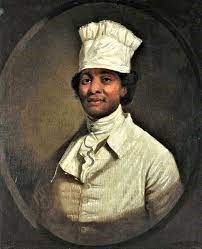By: Dante Parker
Published Feb 13, 2023
If you’re talking about American culinary history, there’s no denying that figures like Julia Child and James Beard have made an impact on the way that we cook. Although we tend to place Black American culinary figures like Edna Lewis, Abby Fisher, and more in their own pocket of history, Black chefs are more than just Black history — they are American history, too. Case in point? Thomas Jefferson’s personal chef and one of the first celebrity chefs in American history, James Hemings.
The sixth child of his enslaved mother, Elizabeth Hemings, James was the second child conceived by her and her owner, John Wayles — the father-in-law to Jefferson. Despite his adverse beginnings, Hemings would later go on to shape American cuisine and influence the way future generations spent time in the kitchen.
Credited for bringing high-class cookery to the States, Hemings’ legacy begins at the age of 8 after his family was inherited by Thomas Jefferson through his wife, Martha. It was under Jefferson’s servitude that Hemings would act as his personal attendant and cook and, later, both the chef de cuisine of Jefferson’s home in Champs-Elysées and head chef of Monticello. His prowess in the kitchen garnered him an uncommon relationship with Jefferson as well as a level of respect amongst Americans that was not common for typical enslaved people.
Although Hemings’ life was filled with many hardships, his resolve and spirit allowed for him to reach heights that would be deemed impressive by modern-day standards. From servitude to head chef to freed man, the life of James Hemings is truly one of inspiration, impact, and triumph.
Here are six things to know about James Hemings, the father of American haute cuisine.
1. James Hemings had a personal relationship with Thomas Jefferson.
James Hemings’ father, John Wayles, was actually Jefferson’s father-in-law, making Hemings and his siblings half-brothers and sisters to Jefferson’s wife. This “elevated” relationship allowed the Hemings family to occupy more notable household positions at Monticello.
2. He was taught how to make French cuisine at the request of Jefferson.
In 1974, Jefferson was appointed as minister to France and was responsible for negotiating treaties of commerce. Upon his appointment, he requested the attendance of 19-year-old Hemings for the “particular purpose” of learning French culinary techniques.
While in France, Hemings studied under caterer Monsieur Combeaux, and apprenticed with several pastry chefs as well as with a cook in the household of the Prince de Condé. After three years of tutelage, Hemings would become the head chef at Hôtel de Langeac, the American embassy — which also served as Jefferson’s residence.
3. Hemings could have been a freed man while in France.
During his time in France, the French did not recognize slavery as a legal act. In fact, French law allowed for slaves — even those brought into the country — to petition the court for their freedom. Although it is not known as to why Hemings did not petition the court, history notes that he willingly returned to America to continue service under Jefferson.
Similarly, upon his return to the States, Hemings could have petitioned once more for his freedom during one of his many trips from New York to Philadelphia. After Jefferson was appointed as the Secretary of State, Hemings acted as his head chef in New York. His duties required him to make several trips to and from Philadelphia and per Pennsylvania law at the time, “If a slave is brought into the State and continues therein for the space of six months, he may claim his freedom.” Per Jefferson’s own personal record, Hemings met the requirement.
4. Hemings is credited for inspiring some of America’s favorite dishes.
Historians note that Jefferson and Hemings are responsible for introducing Americans to crème brûlée. What is not so widely known, though, is that Hemings may also be responsible for introducing Americans to macaroni and cheese. The first recorded mention of mac and cheese was at Monticello in 1802, where it is likely that Hemings prepared or inspired the dish prior to his death one year earlier.
5. He was one of the first known Black “celebrity chefs.”
Although celebrity chefs are extremely easy to come by now, back when Hemings was cooking up meals for Jefferson, the term wasn’t even thought of. Looking back now, however, James Hemings, along with his younger brother Peter Hemings — who became the country’s first master brewer — are not only credited for their dishes, but also for being two of America’s first-known Black celebrity chefs.
6. Hemings died a free man.
As part of a bargain struck between Jefferson and Hemings, Jefferson was willing to grant Hemings his freedom if he could sufficiently train up a replacement to fulfill his vacant duties as head chef at Monticello. Holding up his end of the bargain, Hemings tapped his younger brother, Peter Hemings, for the responsibility and after no more than two years of training, he was given his freedom on February 5, 1796.
As a freed man still residing in Monticello with his enslaved family, Hemings eventually set off on his own in 1801. Not more than two months after his departure from Monticello, rumors began to spread of Hemings’ passing.
Although his life was cut drastically short at the age of 36, the legacy of James Hemings lives on and his story is one of cultural importance. Being the first American to receive French culinary training and bringing his ideas and newly learned methods back to the States, Hemings life serves as an inspiration for historians, modern-day chefs, and African Americans.

